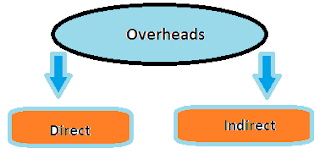How To Accounts: Overheads in Profit & Loss (P/L/( Income Statement)
Variable overhead are
the overhead which varies accordingly with the production level, like it goes
along in proportion with the actual level of the activity for which the
overhead actually relates i.e. higher the production/ Sales of good, higher the variable overhead.
Suppose, if Company A produces
4,000 units of products for which they require $100,000 of raw material and it
the units of products to be increased like say, 5,000 units then the raw
material has to be increased which increases the amount say, $125,000. This is
a perfect example of direct variable cost as it increases/decreases with the
activity level. Again let’s Say, if it is a retails distribution channel which
usually delivers 1 quantity of product at a time and the distribution of the products
varies with the level of sales made i.e. pertaining to the same example as
above if the 4,000 units of products takes $2,000, it is obviously clear, that
to deliver 5,000 units the cost will rise to 2500 which is not specifically a
production related expenses so it is termed as Indirect Variable Expenses.
Fixed Overhead refers
to the overhead that is fixed despite the level of production like the
machinery expenses. There are other sub-terms like step-fixed means the fixed
amount can also change upon reach of the particular production unit. Suppose,
at 4,000 unit level production, the Fixed overhead is $50,000 and the amount is
fixed despite of the level of production of units it has up to 4,000 but when it
goes beyond 4000 unit the fixed amount gets rise to $100,000 up to 8000 unit
so, the production cost can be higher if it finishes up producing the 4100 unit
and the same production cost per unit fall if it goes to the optimal extreme
level of the far end like 4,000 unites and 10,000 units. R & Maintenance of
the Production Plant, Rent on Factory Premise can be referred as an example of
the fixed and step fixed nature of overhead. And it is almost crystal clear
that the fixed and step fixed nature of overhead needs to get optimized in
order to manage the cost per unit of the product.
Semi-variable overhead
is a mixture of both the fixed and variable component in it like, the minimum
threshold is always fixed despite the level of production and it then varies according
to the level of production. For example, bonus or commission designed for the
level of sales like, a company can pay minimum $100 fixed amount as a
commission for 1,000 units of sales. Then again, if the level crosses 2,000
units then the minimum fixed amount increases to $250. Thus the actual payout
varies with the level of sales made. This sort of expenses can be seen
elsewhere in various other departments but the nature is similar. Again, this
can be associated with indirect activities as it particularly doesn’t relate to
the production of the unit.
Ok this is it for now,
in terms of the overheads in P/L (accounting basics) on “how to accounts”.
If you like this
article, then please consider about subscribing.







0 Comments